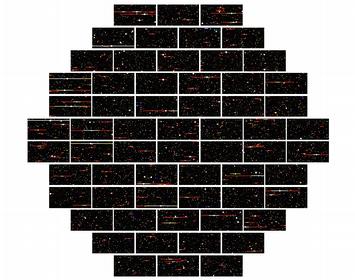DES (Dark Energy Survey)
The external page Dark Energy Survey (DES) is a major new astronomical survey specifically designed to measure the expansion history of the universe to high precision, thus uncovering the nature of the dark energy which is driving this ever-accelerating expansion. Coming online in 2013 and utilizing 525 nights across 5 years, the survey will map over 5000 square degrees of the sky, detecting over 300 million galaxies. ETH Zurich is one of 23 participating institutions from 6 countries, with a total collaboration of over 120 scientists.
The key element of the survey is the dedicated, purpose-built, state-of-the art astronomical camera, external page DECam, which will be mounted on the external page Blanco 4-m telescope located at Cerro Tololo Inter-American Observatory in Chile. DECam consists of 74 individual CCDs, mosaiced together to create a 570 Megapixel imager, with a total field of view of over 4 square degrees.
DES will allow us to measure the expansion history of the universe using four main probes: type Ia supernovae, baryon acoustic oscillations, galaxy clusters, and weak lensing. One of the strengths of DES is its ability to measure each of these simultaneously, allowing us to better account for any inherent biases, and greatly improving our final uncertainties. Of course, such a rich data set will also be an extremely important tool in the next generation of studies in many other areas of astrophysics as well, including galaxy evolution, the Milky Way and Local Group, stellar evolution, and even the solar system.


